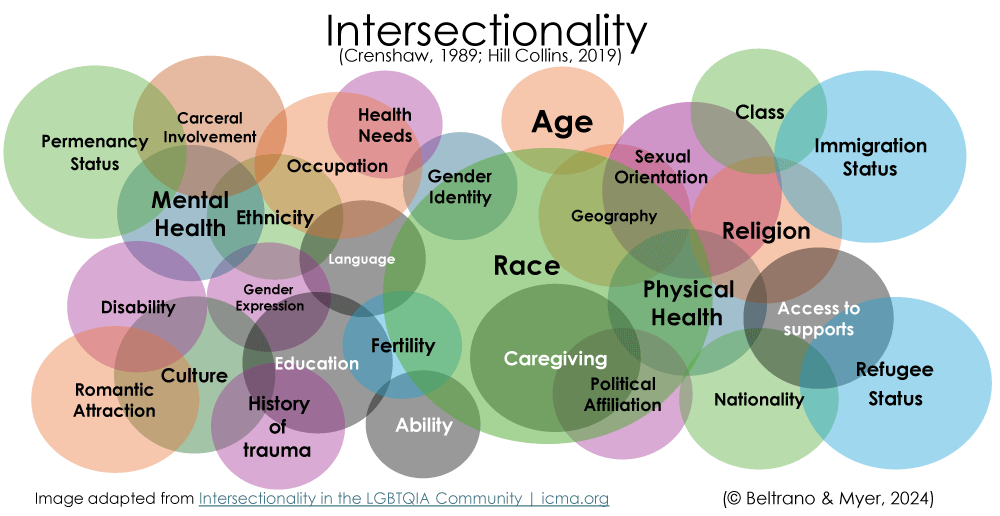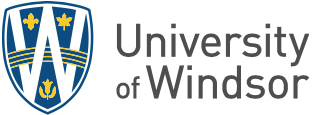Teaching and Learning Resources
Inclusive Teaching and Learning
- Intersectionality Lens
- ADAPT Model of Inclusive Teaching
- Universal Design for Learning
- Examples of Practices and Strategies
- Guides for implementation
- Additional Resources
Intersectionality Lens
Inclusive teaching begins by applying an intersectional lens to understand you and students’ identities. Through the application of an intersectional lens, you begin to identify how you and students’:
- Navigate systemic oppression, barriers, and inequities through a race-based perspective
- Manage competing social demands
- Physical, emotional, and mental health needs may create challenges to participating in the physical and social spaces of the campus community and classroom environment
- Historical experiences in education inform ways of engaging with learning
- Values, beliefs, and cultural norms are centred as ways of being or are silenced due to marginalization

(Crenshaw, 1989; Hill Collins, 2019) This image does not account for all intersecting identities that result in experiences of oppression, discrimination, or inequities nor all identities that contribute to experiences of power and privilege.
ADAPT Model of Inclusive Teaching
Account for Students’ Strengths and Needs: Who are the students in the classroom and what intersecting identities do they experience? How do they experience oppression, discrimination or racism? How do students experience privilege or power?
- How do you greet students from the first day of the course (e.g., welcome messages)?
- How do you build relationships with students? See Positionality and Inclusivity Statements | Centre for Teaching and Learning (CTL) (uwindsor.ca) for additional information
- How do you support students to build relationships with each other?
- How do you build a community of learning in your classroom?
Demands of the Classroom: How is your classroom set-up, both the physically and emotionally? Before you start teaching, look around the room and reflect on:
- Is the classroom accessible? Can someone with a wheelchair or other devices used for physical mobility easily navigate the room? Is there sufficient lighting? Will students be able to hear no matter where they sit?
- What resources, such as PowerPoints, textbooks or other materials do you use to teach? Are they accessible for all students; this includes their physical availability and their use by students who experience disabilities?
- How are materials accessed? Are they available in a variety of formats (e.g., included in both word and PDF)?
- Use headings (Styles in Word) to allow for easy navigation within documents and for those with screen readers
- Ensure you have closed captioning on all videos
- Is there a figure or diagram on the screen? If so, describe it verbally.
- How are ways of knowing and being integrated into the classroom?
- See Postsecondary Course Accessibility Guide (uwaterloo.ca) for additional information
Adaptations of the Classroom Expectations: What are the needs of students in comparison to the expectations of the classroom?
- What learning supports do you implement to assist all students to succeed? See Assessment Design | Centre for Teaching and Learning (CTL) (uwindsor.ca) for more information
- Examples:
- Scaffolded assessments with multiple opportunities for formative feedback
- Student-centred learning approaches (How will you adapt interactive activities such as Mentimeter for those who cannot access it?.
- Active learning opportunities
- Facilitating Discussions | Centre for Teaching and Learning (CTL) (uwindsor.ca)
- Examples:
- How can you ensure all students have equitable opportunities in the classroom and in the expectations of the class?
- Examples:
- Have you considered flexible deadlines?
- Student-driven approaches to presenting learning (e.g., portfolios or recorded presentations in comparison to written essays)
- See High Impact Practices | Centre for Teaching and Learning (CTL) (uwindsor.ca) for additional information
- Examples:
Perspective and Consequences: How do students’ experiences and their identities integrated into curriculum and content, teaching methods and approaches, and assessments and evaluations?
- What curriculum and content do you focus on, and how are ways of knowing and being integrated?
- How do you integration Indigenization and the goals of Truth and Reconciliation? See Indigenous Knowledges | Centre for Teaching and Learning (CTL) (uwindsor.ca) for additional information
- How do you address systemic anti-Black racism and microaggressions that occur in class? See Anti-Black Racism and Anti-Racism Resources | Centre for Teaching and Learning (CTL) (uwindsor.ca) for additional information
- Do you include voices who have been silenced or marginalized?
Teach and Assess the Match: This means reflecting on your adaptive approaches and understanding what worked, what did not work and how you can further adapt.
- How do you collect feedback from students to see if their learning needs are being met?
- How do you integrate this feedback?
- What needs to change or be further adapted to enhance students’ opportunities for learning?
- See Gathering Feedback on Teaching | Centre for Teaching and Learning (CTL) (uwindsor.ca) for more information
Universal Design for Learning
CAST: About Universal Design for Learning
Postsecondary Course Accessibility Guide (uwaterloo.ca)
Universal Design for Instruction and Teaching Strategies (uwindsor.ca)
Examples of UDL Principles in Practice
|
Category and Principle |
Example(s) |
|
Multiple Means of Engagement |
|
|
Offer content and activities that are relevant to students’ lives and interests. |
Provide the option of choosing from a variety of assignment topics so students can select one they identify with |
|
Provide mastery-oriented feedback that guides students towards long-term success. |
Provide feedback that identifies patterns of errors and offers strategies for success |
|
Provide opportunities for learners to reflect and monitor their progress. |
Offer checklists, time for personal reflection, templates or peer feedback activities. |
|
Multiple Means of Representation |
|
|
Present information in a variety of formats so students can engage with content in the ways that best meet their learning preferences and/or needs. |
Ensure PowerPoint presentations include alt text so the content is accessible to students using screen readers; provide content and multimedia in a variety of file formats and/or software |
|
Decode key vocabulary and discipline-specific language for students. |
Hyperlink when possible to definitions of key terms and/or illustrations that provide clarity; provide a course glossary of definition, key terms and/or acronyms. |
|
Activate relevant prior knowledge. |
Encourage students to co-create a “reference sheet” of core concepts learned in previous, related courses |
|
Multiple Means of Action and Expression |
|
|
Offer students options to demonstrate what they have learned in relation to course learning goals. |
Provide the option of earning participation grades through oral contributions in class and/or written, audio or video contributions posted to a shared bulletin or blog; provide the option of completing course presentations synchronously in class, synchronously remotely or asynchronously via video file submission. |
|
(Courts et al., 2023) |
|
Guides for Implementation
Inclusive Syllabus - UWindsor
Inclusive Syllabus - UManitoba
Additional Resources
Building a Respectful Teaching Environment
Inclusive Curriculum and Assessment Design
Towards More Trans-Inclusive Classrooms: An Introduction
References:
Courts, R., Chatoor, K., Pichette, J., Okojie, O., & Tishcoff, R. (2023). HEQCO’s Dialogues on Universal Design for Learning: Finding common ground and key recommendations from the sector. Toronto: Higher Education Quality Council of Ontario. HEQCO’s Dialogues on Universal Design for Learning: Finding Common Ground and Key Recommendations from the Sector – Higher Education Quality Council of Ontario
DePaul University (2024). Teaching Commons. https://resources.depaul.edu/teaching-commons/teaching-guides/inclusive-teaching/Pages/default.aspx
Crenshaw, K. (1989). Demarginalizing the intersection of race and sex: A black feminist critique of antidiscrimination doctrine, feminist theory and antiracist politics. University of Chicago Legal Forum, 139-168. https://chicagounbound.uchicago.edu/cgi/viewcontent.cgi?article=1052&context=uclf
Hill Collins, P. (2019). Intersectionality as critical social theory. Duke University Press.
Hutchinson, N. L. & Specht, J. A. (2020). Inclusion of learners with exceptionalities in Canadian schools: A practical handbook for teachers (6th ed.). Pearson
© Created by Natalie Beltrano, 2024
